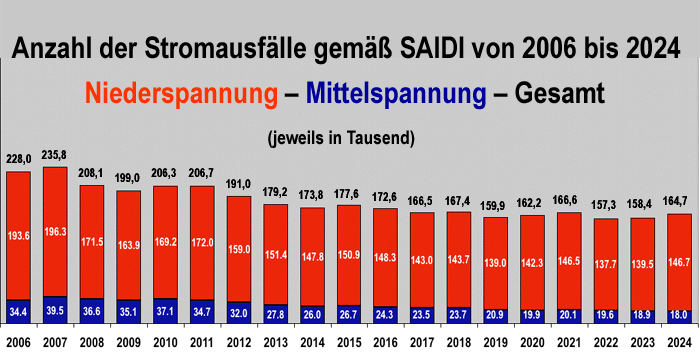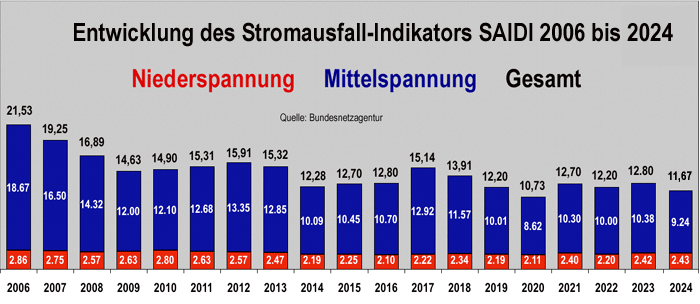|
|
|
|
Power outages increased by four percent, but were resolved more quickly
On October 9, the Federal Network Agency published the latest figures on power outages in 2024. According to these figures, 830 network operators reported a total of 164,645 low- and medium-voltage supply interruptions lasting longer than three minutes (only such interruptions are recorded by the SAIDI power outage indicator). The number of fault reports thus increased by around 6,300 reports or four percent compared to the previous year (see Graph 2). Nevertheless, the average duration of power outages per end consumer decreased slightly in 2024: as they could be rectified more quickly, it took only 11.68 minutes to eliminate the fault, compared with 12.80 minutes in the previous year (see Graph 1).
In addition to the minimum duration of more than three minutes, the interruptions must be attributable to the actions of third parties, repercussions from other grids, or other disruptions in the grid operator's area. Planned interruptions and outages due to force majeure are not taken into account, nor are voltage and frequency fluctuations, which can also impair the quality of supply.
The Federal Network Agency calculates the System Average Interruption Duration Index (SAIDI) from all unplanned interruptions that are not attributable to events of force majeure. This index reflects the average supply interruption per connected end consumer within a calendar year. In addition to the key figures on power supply interruptions per federal state, an anonymized list of fault reports is published.
 |
|
This graph illustrates that although most power outages originate in the medium-voltage grid (see Graph 1), they only affect a relatively small number of end consumers who have particularly high power requirements and are therefore connected directly to a level between low voltage (up to 1000 volts) and less than 100 kilovolts (“high voltage” of the distribution grid). In terms of numbers, end consumers in households and businesses connected to the downstream low-voltage grids are much more severely affected. |
Official survey replaced voluntary fault statistics
Until 2005, German network operators determined the quality of supply on
a voluntary basis, initially in the “VDEW Fault and Damage Statistics”
from 1994 and in the “VND Fault and Availability Statistics” from 2004.
Since the new Energy Industry Act came into force in July 2005, network
operators have been required under § 52 EnWG to submit a
report to the Federal Network Agency by June 30 of each year on all
supply interruptions that occurred in their network during the previous
calendar year. Among other things, the average supply interruption in
minutes per end consumer must be specified. The Incentive Regulation
Ordinance, in turn, stipulates that the quality of supply determined in
this way is one of the criteria for the amount of investment that the
network operator must make, in accordance with §
21 ARegV.
Report on security of supply considers expansion of up to 22.4 GW of controllable capacity to be necessary – in the worst case, even up to 35.5 GW
On September 3, the German government published the “Report on the Status and Development of Security of Supply in the Electricity Sector,” which the Federal Network Agency is required to submit every two years in accordance with § 51 Abs. 3 and § 63 Abs. 2 of the Energy Industry Act. The report examines two scenarios:
- One target scenario assumes that the legal and political goals will be achieved.
- A “delayed energy transition” scenario examines how, for example, a delayed expansion of renewables and lower demand flexibility would affect security of supply.
According to the report, the electricity supply in Germany will be guaranteed if additional controllable capacities of up to 22.4 GW (target scenario) or up to 35.5 GW (delayed energy transition scenario) are installed by 2035. These are gross values that quantify the expansion without decommissioning. A comparison of the two scenarios shows that a lack of or delay in making electricity consumption more flexible can further increase the need for additional controllable capacities such as power plants. Delays in the expansion of generation facilities, especially renewable generation, could also mean that the electricity market is unable to fully meet demand. In such situations, additional reserves outside the electricity market would have to be used to ensure security of supply. As investment in controllable capacity has been insufficient to date, it is important to support expansion. The Federal Network Agency therefore supports the legal framework planned by the federal government for additional power plants to be built by 2030.
Links (internal)
- Quality of electricity supply remains high (241109)
- Companies complain about increase in short-term power outages (240507)
- Security of electricity supply remains very high (231107)
- Office for Civil Protection regrets misleading statement on power outage risk (221112)
- Security of supply even greater than in the previous year (210810)
- Security of supply was higher than ever in 2019 (201014)
- List of links to power supply disruptions and security of supply
Link (external, no guarantee)
- PDF Report on the status and development of security of supply in the area of electricity supply, as of September 2025 (79 pages)
